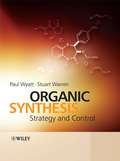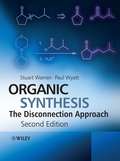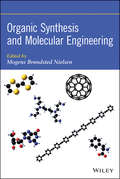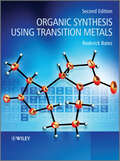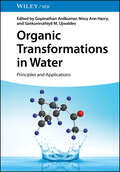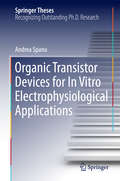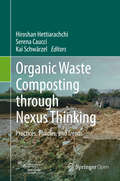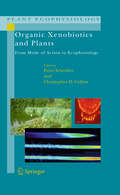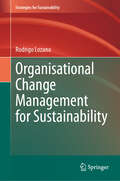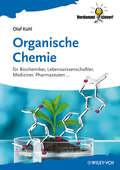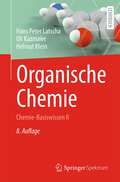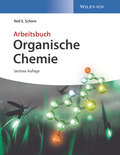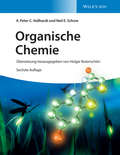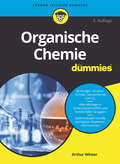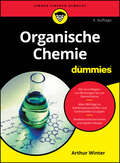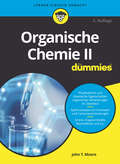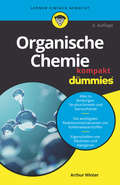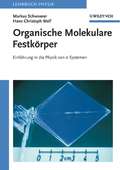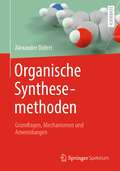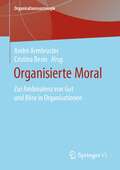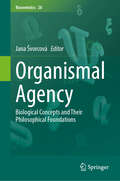- Table View
- List View
Organic Synthesis: Strategy and Control
by Paul Wyatt Stuart WarrenOrganic Synthesis: Strategy and Control is the long-awaited sequel to Stuart Warren's bestseller Organic Synthesis: The Disconnection Approach, which looked at the planning behind the synthesis of compounds. This unique book now provides a comprehensive, practical account of the key concepts involved in synthesising compounds and focuses on putting the planning into practice. The two themes of the book are strategy and control: solving problems either by finding an alternative strategy or by controlling any established strategy to make it work. The book is divided into five sections that deal with selectivity, carbon-carbon single bonds, carbon-carbon double bonds, stereochemistry and functional group strategy. * A comprehensive, practical account of the key concepts involved in synthesising compounds * Takes a mechanistic approach, which explains reactions and gives guidelines on how reactions might behave in different situations * Focuses on reactions that really work rather than those with limited application * Contains extensive, up-to-date references in each chapter Students and professional chemists familiar with Organic Synthesis: The Disconnection Approach will enjoy the leap into a book designed for chemists at the coalface of organic synthesis.
Organic Synthesis
by Paul Wyatt Stuart WarrenOrganic Synthesis: Strategy and Control is the long-awaited sequel to Stuart Warren's bestseller Organic Synthesis: The Disconnection Approach, which looked at the planning behind the synthesis of compounds. This unique book now provides a comprehensive, practical account of the key concepts involved in synthesising compounds and focuses on putting the planning into practice.The two themes of the book are strategy and control: solving problems either by finding an alternative strategy or by controlling any established strategy to make it work. The book is divided into five sections that deal with selectivity, carbon-carbon single bonds, carbon-carbon double bonds, stereochemistry and functional group strategy.A comprehensive, practical account of the key concepts involved in synthesising compoundsTakes a mechanistic approach, which explains reactions and gives guidelines on how reactions might behave in different situationsFocuses on reactions that really work rather than those with limited applicationContains extensive, up-to-date references in each chapterStudents and professional chemists familiar with Organic Synthesis: The Disconnection Approach will enjoy the leap into a book designed for chemists at the coalface of organic synthesis.
Organic Synthesis and Molecular Engineering
by Mogens Brøndsted NielsenThe theory, methods, and practices needed to build molecules and supramolecular systemsUsing a synthetic approach to organic materials chemistry, this book sets forth tested and proven methods and practices that make it possible to engineer organic molecules offering special properties and functions. Throughout the book, plenty of real-world examples demonstrate the countless possibilities of creating one-of-a-kind molecules and supramolecular systems to support a broad range of applications. The book explores applications in both materials and bioorganic chemistry, including molecular electronics, energy storage, sensors, nanomedicine, and enzyme engineering.Organic Synthesis and Molecular Engineering consists of fourteen chapters, each one contributed by one or more leading international experts in the field. The contributions are based on a thorough review and analysis of the current literature as well as the authors' firsthand experience in the lab engineering new organic molecules. Designed as a practical lab reference, the book offers:Tested and proven synthetic approaches to organic materials chemistryMethods and practices to successfully engineer functionality into organic moleculesExplanations of the principles and concepts underlying self-assembly and supramolecular chemistryGuidance in selecting appropriate structural units used in the design and synthesis of functional molecules and materialsCoverage of the full range of applications in materials and bioorganic chemistryA full chapter on graphene, a new topic generating intense researchOrganic Synthesis and Molecular Engineering begins with core concepts, molecular building blocks, and synthetic tools. Next, it explores molecular electronics, supramolecular chemistry and self-assembly, graphene, and photoresponsive materials engineering. In short, it offers everything researchers need to fully grasp the underlying theory and then build new molecules and supramolecular systems.
Organic Synthesis Using Transition Metals
by Roderick BatesTransition metals open up new opportunities for synthesis, because their means of bonding and their reaction mechanisms differ from those of the elements of the s and p blocks. In the last two decades the subject has mushroomed - established reactions are seeing both technical improvements and increasing numbers of applications, and new reactions are being developed. The practicality of the subject is demonstrated by the large number of publications coming from the process development laboratories of pharmaceutical companies, and its importance is underlined by the fact that three Nobel prizes have been awarded for discoveries in this field in the 21st Century already.Organic Synthesis Using Transition Metals, 2nd Edition considers the ways in which transition metals, as catalysts and reagents, can be used in organic synthesis, both for pharmaceutical compounds and for natural products. It concentrates on the bond-forming reactions that set transition metal chemistry apart from "classical" organic chemistry. Each chapter is extensively referenced and provides a convenient point of entry to the research literature. Topics covered include:introduction to transition metals in organic synthesiscoupling reactionsC-H activationcarbonylative coupling reactionsalkene and alkyne insertion reactionselectrophilic alkene and alkyne complexesreactions of alkyne complexescarbene complexesh3- or p-allyl -allyl complexesdiene, dienyl and arene complexescycloaddition and cycloisomerisation reactionsFor this second edition the text has been extensively revised and expanded to reflect the significant improvements and advances in the field since the first edition, as well as the large number of new transition metal-catalysed processes that have come to prominence in the last 10 years - for example the extraordinary progress in coupling reactions using "designer" ligands, catalysis using gold complexes, new opportunities arising from metathesis chemistry, and C-H activation - without neglecting the well established chemistry of metals such as palladium.Organic Synthesis Using Transition Metals, 2nd Edition will find a place on the bookshelves of advanced undergraduates and postgraduates working in organic synthesis, catalysis, medicinal chemistry and drug discovery. It is also useful for practising researchers who want to refresh and enhance their knowledge of the field.
Organic Thermoelectrics: From Materials to Devices
by Daoben ZhuOrganic Thermoelectrics Enables readers to understand the development and applications of organic thermoelectric conversion, including fundamentals and experimental breakthroughs Organic Thermoelectrics: From Materials to Devices introduces organic thermoelectric materials to devices in a systematic manner, covering the development of organic thermoelectric materials, followed by a discussion on the fundamental mechanism of thermoelectric conversion, design strategy, and advances in different materials, device fabrication, and characterizations of thermoelectric parameters. In Organic Thermoelectrics: From Materials to Devices, readers can expect to find detailed information on: Fundamentals of thermoelectric (TE) conversion, development of organic thermoelectric (OTE) fields and mechanisms, and basic physical processes in carrier transport and thermal transport for TE conversion Recent development and key strategies to develop p-type, n-type, and composite/hybrid OTE materials Basic mechanisms, fundamental requirements, and recent advances of doping for OTE applications, plus geometries and construction methods of OTE devices Theoretical and experimental advances in single molecular TE devices, together with the recent development in related detection methods Powered by worldwide innovative research results in the past ten years and strongly supported by many collaborators, Organic Thermoelectrics is a comprehensive reference on the subject and is invaluable for scientists and students in chemistry, materials, and engineering.
Organic Transformations in Water: Principles and Applications
by Gopinathan Anilkumar Nissy Ann Harry Sankuviruthiyil M. UjwaldevHarness sustainable, environmentally friendly chemical processes with this timely volume Green chemistry has played a leading role in the broader search for environmentally sustainable industry. One of its most important goals is the shift from volatile, hazardous organic solvents to environmentally friendly ones, of which by far the most promising is water. Cultivating organic transformations using water as a solvent is one of the most crucial steps towards the creation of green, sustainable chemical production processes. Organic Transformations in Water provides a cutting-edge overview of water as a reaction medium for synthesis and catalysis. After a brief introduction, the book moves through each of the most important classes of organic transformation before concluding with a survey of industrial applications. The book will also cover: Chemistry and physicochemical aspects of “on-water” and “in-water” reactionsC–H activation, metathesis, nucleophilic addition and substitution, oxidation and reduction, and many moreAsymmetric organic reactions in waterApplications in organocatalysis, electrocatalysis, and photocatalysis Timely and comprehensive, Organic Transformations in Water is a must-own volume for researchers and industry professionals looking to revolutionize their work in a sustainable way.
Organic Transistor Devices for In Vitro Electrophysiological Applications
by Andrea SpanuThis thesis reports on a novel system forextracellular recordings of the activity of excitable cells, which relies on anorganic, charge-modulated field-effect transistor (FET) called OCMFET. Thebook shows how, thanks to the intrinsic biocompatibility, lightness, andinexpensiveness of the material used, this new system is able to overcome severalproblems typical of of "classic" electronic andbioelectronic. Itprovides a full description of the system, together with a comprehensive reportof the successful experimental trials carried out on both cardiac and nervecells, and a concise yet comprehensive overview of bioelectronic interfaces andorganic sensors for electrophysiological applications.
Organic Waste Composting through Nexus Thinking: Practices, Policies, and Trends
by Hiroshan Hettiarachchi Serena Caucci Kai SchwärzelOrganic waste composting is another excellent example to demonstrate the power and the benefits of nexus thinking. Even though organic waste composting itself is not a new topic, those who want to start a new project or align an ongoing project with nexus thinking, find it difficult to gather the necessary information. With nine case studies from four continents, this book aims to fill above gap in literature. While current literature on composting is often found to be limited to either soil/agriculture sector or waste management sector, this book presents a combined point of view. This open access book starts with an introductory chapter that describes the need to bring the waste management aspects and soil nutrient management aspects of compost production into one integrated theme. The relevance of nexus thinking and the Sustainable Development Goals (SDGs) are also presented in this introduction. The first three chapters after the introduction covers composting from the solid waste management and its policy aspects, taking examples from three developing countries. The next three examples are mostly about the benefits composting can provide to the soil and agriculture. These examples are also from three developing countries, but with a mixture of urban as well as rural settings. Last three chapters present more insight into the latest developments taking examples from Europe, as well as new methods adapted from the traditional styles from Africa.
Organic Waste to Biohydrogen (Clean Energy Production Technologies)
by Mohammed Kuddus Ghazala Yunus Pramod W. Ramteke Gustavo MolinaThis book provides an updated knowledge on the biohydrogen production from industrial and municipal organic waste materials. Microbes are increasingly being included in the hydrogen based biofuel production and this book covers the processes and protocols for biohydrogen production. There is an urgent need of alternative energy research to fulfill the global energy demand. Biohydrogen is a promising source of sustainable and clean energy as it harnessed by biological means. Biohydrogen may be produced by utilizing different waste materials as a substrate, and by optimization of various parameters of bioreactors such as temperature, pH, partial pressure etc. The waste materials used in hydrogen production are categorized as agricultural waste, municipal waste, industrial waste, and other hazardous wastes. Biohydrogen production from wastes materials opened a new opportunity for the widespread use of everlasting renewable energy source. This book is useful for professional scientists, academicians, biotechnologist and environmentalist along with research scholars in various biotechnology and bioenergy industries by addressing the latest research going on in the field of renewal bioenergy production from waste and their global impact on the environment.
Organic Xenobiotics and Plants
by Christopher D. Collins Peter SchröderNatural and agro-ecosystems are frequently exposed to natural or synthetic substances, which, while they have no direct nutritional value or significance in metabolism, may negatively affect plant functioning. These, xenobiotics, may originate from both natural (fires, volcano eruptions, soil or rock erosion, biodegradation) and anthropogenic (air and soil pollution, herbicides) sources. And, while affected plants have only a limited number of possibilities for avoiding accumulation of these compounds, they do exhibit several enzymatic reactions for detoxification including oxidation, reduction, hydrolysis and conjugation reactions. In agro-ecosystems in particular these mechanisms have great significance in relation to herbicide detoxification and tolerance. In this volume an international group of experts present an overview of the nature and distribution of organic xenobiotics, including their uptake, effects on plant functioning and detoxification mechanisms. The particular significance of glutathione S-transferases in bio-indication and bio-monitoring, and in the detoxification of volatile organic air pollutants and herbicides is evaluated, and their potential significance in phytoremediation and bioaccumulation will be discussed. This volume will be of interest to a wide audience, from graduate students to senior researchers in a wide range of disciplines including plant ecology, plant biochemistry, agriculture and environmental management. It will also be of practical interest to environmentalists, policy makers and resource managers.
Organisational Change Management for Sustainability (Strategies for Sustainability)
by Rodrigo LozanoThis book is aimed at providing clarity through a systemic and systematic approach to organisational change management for sustainability. Chapter 2 of the provides an overview of sustainable development and sustainability discourses, focussing on the economic, environmental, social, and time dimensions, as well as their interactions. Chapter 3 explains what organisations are, the types of organisations (civil society, corporations, education, public sector, and hybrid), the levels and system elements (individuals, groups, organisation, and system), attitudes (informational, emotional, and behavioural), the stakeholders that affect and are affected by the organisation, and the interactions between organisations (from competition to collaboration). Chapter 4 focuses on how organisations have been addressing sustainability, divided into 1) efforts to contribute to sustainability (i.e. focussing outside the organisation), and 2) engagement efforts (i.e. those focussing inside the organisation, e.g. through the use of tools, initiatives, and approaches for sustainability, and collaboration). Chapter 5 discusses change, types of change (internal vs. external, proactive vs. reactive, etc.), change strategies, change frameworks, and change for sustainability in organisations. Chapter 6 focusses on three key mechanisms for sustainability: Leadership, Governance, and Assessment and reporting (with examples from Higher Education Institutions, corporations, and public sector organisations). Chapter 7 discusses on the different drivers (internal, connecting, and external) that foster sustainability in organisations. Examples from empirical research are presented. Chapter 8 delves into resistance to change, particularly on the barriers that slow down or stop sustainability in organisations, as well as the strategies to overcome the barriers to change. Examples from empirical research are presented. The seventh chapter focuses on the different strategies that help reduce or eliminate resistance to sustainability in organisations. Examples from empirical research are presented. Chapter 9 focusses on where sustainability efforts have started (incorporation) and how have they been adopted throughout the organisation (institutionalisation). Examples from empirical research are presented. Chapter 10 presents the effects of external stimuli, such as COVID-19 on organisational change management for sustainability.
Organisationen nachhaltig bewegen: Systemische Organisationsentwicklung zum Nachhaltigen Unternehmen (BestMasters)
by Christiane Lüschen-HeimerOrganisationen sind das Zentrum unserer Gesellschaft. Als solche sind sie Vorreiterinnen in der Entwicklung nachhaltiger Abläufe zur Abwendung der Klimakatastrophe.Dieses Buch lädt ein, Nachhaltigkeit systemtheoretisch zu definieren und bietet über dieses Verständnis ein Haltungs- und Handlungsmodell für den Veränderungsprozess. Er wird möglich, wenn wir Organisationen nicht mehr als Zusammenschluss von Subsystemen und organisationalen Abläufen betrachten. Wenn wir sie in der Einheit von Ökologie, Ökonomie und dem sozialen (menschlichen) Aspekt verstehen, ist eine nachhaltige Transformation möglich. Dann erst ist das Unternehmen/die Organisation den Menschen und der Gesellschaft förderlich. Der systemische Blick auf Organisation und nachhaltige Transformation befähigt Menschen.
Organische Chemie: für Biochemiker, Lebenswissenschaftler, Mediziner, Pharmazeuten... (Verdammt clever!)
by Olaf KühlKompakt und »verdammt clever« auf den Punkt gebracht - so wird in diesem klar strukturierten Lehrbuch die organische Chemie sehr verständlich präsentiert. Nicht nur für angehende Chemiker, Biochemiker und Chemieingenieure, sondern auch für alle Studierenden der Lebenswissenschaften, Medizin und Pharmazie zählt die organische Chemie zu den wichtigsten Fächern. Mit dem Blick aufs Wesentliche gerichtet, sind von den grundlegenden Bindungskonzepten, den wichtigsten Reaktionsmechanismen, den unterschiedlichen Reaktivitäten der zentralen funktionellen Gruppen und Verbindungsklassen bis hin zum Konzept der Aromatizität alle prüfungsrelevanten Lerninhalte äußerst verständlich erklärt und abgedeckt. Dabei unterstützen besondere Textelemente Ihren Lernerfolg: * Für inhaltliche Orientierung sorgen optisch hervorgehobene Schlüsselthemen am Kapitelanfang. * Das Wichtigste wird kurz und prägnant in Defi nitionen und Merksätzen zusammengefasst. * Ideale Hilfe beim Nachschlagen von relevanten Stichworten und Begriffen bietet ein Glossar. * Wissenstest und Prüfungsvorbereitung: Aufgaben mit Lösungen helfen ungemein beim eigenständigen Überprüfen des Gelernten.
Organische Chemie: Chemie-Basiswissen II
by Hans Peter Latscha Uli Kazmaier Helmut KleinDie Reihe Chemie-Basiswissen stellt den gesamten Wissensstoff für das Bachelorstudium Chemie dar. Studenten mit Chemie im Nebenfach und Studierende des höheren Lehramtes dient sie zur Examensvorbereitung. Der Band II, Organische Chemie, präsentiert den Stoff dieses Gebietes in kurzer und übersichtlicher Form. Das didaktische Konzept und die am Curriculum orientierte Stoffauswahl haben das Buch bei Haupt- und Nebenfachstudenten der Chemie sowie Studierenden des höheren Lehramtes beliebt gemacht. Die 8. Auflage wurde vollständig durchgesehen und aktualisiert und um ein Kapitel über Chemikaliensicherheit und Gefahrstoffrecht erweitert. Ebenfalls neu hinzugekommen sind Übungsaufgaben mit Lösungen zu den einzelnen Kapiteln.
Organische Chemie: Arbeitsbuch (Wiley-vch-lehrbuchkollektion 1 Ser.)
by Neil E. SchoreEndlich - die 6. Auflage des "Vollhardt/Schore" ist da! Das Arbeitsbuch enthält alle Lösungen der Übungsaufgaben des Lehrbuchs. Im Mittelpunkt des seit Jahrzehnten erfolgreichen Lehrbuchs stehen das Verständnis von Reaktionen, Strukturen, Mechanismen und Synthesen - das Fundament der organischen Chemie. -über 650 gelöste Aufgaben helfen, den Stoff zu vertiefen -Lehrbuch und Arbeitsbuch auch als preislich attraktives Set in der Deluxe-Edition erhältlich Der "Vollhardt/Schore" ist der Schlüssel zum Erfolg - nicht nur für Chemiestudenten, sondern auch für Biochemiker, Pharmazeuten, Biologen und Mediziner.
Organische Chemie: Arbeitsbuch (Wiley-vch-lehrbuchkollektion 1 Ser.)
by Neil E. Schore K. Peter VollhardtEndlich - die 6. Auflage des bewährten "Vollhardt/Schore" ist da! Neu und modern gestaltet vermittelt das Lehrbuch verständlich und übersichtlich das Wissen der organischen Chemie. Der komplette Text wurde überarbeitet, aktualisiert und erweitert. Im Mittelpunkt des seit Jahrzehnten erfolgreichen Lehrbuchs stehen das Verständnis von Reaktionen, Strukturen, Mechanismen und Synthesen - das Fundament der organischen Chemie. Neu: Lernziele am Anfang des Kapitels geben einen praktischen Leitfaden über den Lernstoff eines jeden Kapitels Neu: die Rubrik "Wirklich?" nennt überraschende und ungewöhnliche Fakten Neu: "Wir fassen zusammen" - eine hilfreiche und kurze Zusammenfassung am Ende eines jeden Teilkapitels Neu: zusätzliche erklärende Kommentare erläutern detailliert die ablaufenden Reaktionsmechanismen - über 1600 Seiten prall gefüllt mit dem Wissen über die organische Chemie zu einem unschlagbaren Preis -Zahlreiche Exkurse zu fluorinierten Pharmazeutika, gefälschten pflanzlichen Arzneistoffen u.a. unterstreichen die Rolle der organischen Chemie im Alltag -"Im Überblick" am Ende jedes Kapitels fasst die wichtigsten Inhalte in kompakter Form zusammen -Einseitige Übersichten fassen die Hauptreaktionen der funktionellen Gruppe zusammen -zahlreiche Verständnisübungen mit ausführlich ausgearbeiteten Lösungswegen helfen den Lernstoff zu vertiefen -über 650 gelöste Aufgaben im Lehrbuch helfen, den Stoff zu vertiefen -das dazugehörige Arbeitsbuch bietet zusätzlich die Lösungen aller Übungen -Lehrbuch und Arbeitsbuch auch als preislich attraktives Set in der Deluxe-Edition erhältlich Der "Vollhardt/Schore" ist der Schlüssel zum Erfolg - nicht nur für Chemiestudenten, sondern auch für Biochemiker, Pharmazeuten, Biologen und Mediziner.
Organische Chemie für Dummies (Für Dummies)
by Arthur WinterMan könnte meinen, dass eine Wissenschaft, die sich hauptsächlich mit Verbindungen eines einzigen Elements auseinandersetzt, vergleichsweise übersichtlich ist. Doch Kohlenstoff ist ein ganz besonderes Element, denn Kohlenstoffverbindungen bilden die Grundlagen des Lebens. "Organische Chemie für Dummies" führt Sie in die Geheimnisse der organischen Verbindungen ein, erklärt Ihnen die Grundlagen der Spektrometrie und Spektroskopie, zeigt Ihnen, welche Reaktionen möglich und welche unmöglich sind und vieles mehr. Nach jedem Kapitel finden Sie Übungsaufgaben mit ausführlichen Lösungen. So unterstützt Sie das Buch bei Ihrem Einstieg in die Organische Chemie.
Organische Chemie für Dummies (Für Dummies)
by Arthur WinterHier dreht sich alles um Kohlenstoff Wie die Zusammenhänge und Konzepte der organischen Chemie funktionieren, lernen Sie in diesem Buch. Arthur Winter erklärt Ihnen, was Sie über Kohlenstoffverbindungen, funktionelle Gruppen und Reaktionsmechanismen wissen sollten. So erfahren Sie, welche Reaktionen möglich und welche unmöglich sind. Außerdem vermittelt er leicht verständlich auch komplexe Themen wie die Stereochemie und die Spektroskopie. Zu jedem Kapitel gibt es Übungsaufgaben und ausführlichen Lösungen. So unterstützt Sie das Buch nicht nur theoretisch, sondern auch praktisch bei Ihrem Einstieg in die Organische Chemie. Sie erfahren Wie Sie organische Strukturen korrekt zeichnen Wie Sie Reaktionsmechanismen erarbeiten Was Sie über Säuren, Basen und den pKs-Wert wissen sollten Welche Fachbegriffe Sie kennen müssen
Organische Chemie II für Dummies (Für Dummies)
by John T. MooreDie Organische Chemie, die Welt des Kohlenstoffs, ist spannend, vielschichtig und manchmal auch ein wenig schwer zu verstehen. Wenn Sie mehr als nur die Grundlagen der Organik verstehen müssen und etwas tiefer in die Materie eindringen wollen, sind Sie hier genau richtig. Nach einer kurzen Wiederholung der Grundlagen erfahren Sie, was aromatische Verbindungen ausmacht, wie die aromatische Substitution abläuft und was Sie über Aldehyde, Ketone, Enole und Carbonsäuren wissen sollten. Auch kniffelige Themen wie Organometalle, Amine und Biomoleküle kommen nicht zu kurz. So bietet John T. Moore in diesem Buch einen leicht verständlichen Überblick über die etwas fortgeschrittenere Organische Chemie.
Organische Chemie kompakt für Dummies (Für Dummies)
by Arthur WinterIn der Schule und beim Studium der Naturwissenschaften kommen Sie an der Organischen Chemie nicht vorbei. Doch dieses Buch hilft Ihnen, wenn Sie sich einen schnellen Überblick über dieses komplexe Thema verschaffen wollen. Arthur Winter erklärt Ihnen leicht verständlich, was Sie über Kohlenstoffverbindungen, funktionelle Gruppen und organische Reaktionen unbedingt wissen sollten. So ist dies Ihr perfekter Nachhilfelehrer für die Tasche: freundlich, kompetent, günstig.
Organische Molekulare Festkörper: Einführung in die Physik von pi-Systemen
by Markus Schwoerer Hans Christoph WolfDie Untersuchung der physikalischen Eigenschaften Organischer Festkörper, insbesondere solcher, deren Bausteine konjugierte p-Elektronen-Systeme enthalten, ist in den letzten Jahrzehnten zu einem aktiven und attraktiven Teilgebiet der Festkörperphysik geworden. Hierfür gibt es mehrere Gründe. Zum einen ist es die Vielfalt von Eigenschaften, die sie von den anorganischen Festkörpern unterscheiden. Dazu gehört zum Beispiel die Energieleitung durch Excitonen, also ohne Transport von Ladungen, über größere Distanzen. Mit Hilfe der Chemie lassen sich diese Eigenschaften in weiten Grenzen variieren. Weiter verspricht man sich neue Anwendungsmöglichkeiten, etwa als Organische Leuchtdioden oder in einer neuartigen molekularen Elektronik, welche die auf anorganischen Halbleitern beruhende Elektronik erweitert und ergänzt. Schließlich sind Organische Festkörper ein Bindeglied zwischen Physik und Biologischer Physik. So hat etwa die Organische Festkörperphysik wichtige Beiträge zur Aufklärung der Elementarprozesse der Photosynthese geleistet. Das Buch ist für Studenten im Wahl- oder Spezial-Vorlesungsbereich geschrieben und für solche, die sich selber forschend in diesem Gebiet betätigen wollen. Darüber hinaus wendet es sich an alle Physiker, Physikochemiker und Chemiker, die ihre Kenntnisse über Festkörper erweitern wollen. Das Buch bietet eine Einführung in die Grundlagen mit Verweisen auf ausführlichere Literatur bis hin zu Problemen der aktuellen Forschung
Organische Synthesemethoden: Grundlagen, Mechanismen und Anwendungen
by Alexander DüfertDieses Lehrbuch stellt die wichtigsten modernen und klassischen Methoden/Namensreaktionen der organischen Synthese vor und bei welchen Substraten sie möglichst effizient einsetzbar sind. Basierend auf häufig genutzten Funktionalitäten oder gängigen Reaktionstypen wird dem Leser schrittweise das nötige Handwerkszeug geliefert, um Synthesen nachvollziehen zu können oder diese selbständig zu konzipieren.Aus dem Inhalt:- Bewertung und Vergleich der wichtigsten Synthesemethoden inklusive umfassendem Literaturverzeichnis- Ausführliche Erläuterung der Mechanismen- Zahlreiche Beispiele für den Einsatz der Methoden in komplexen Synthesen- Ansätze zur Erstellung und Optimierung von Syntheserouten im akademischen und industriellen UmfeldEin besonderer Fokus wird auf das Verständnis der jeweiligen Reaktionsmechanismen gelegt. So können die Selektivität einer Reaktion und die Kompatibilität gegenüber typischen funktionellen Gruppen begriffen und vorhergesagt werden. Neue Entwicklungen über den Rahmen des hier dargestellten hinaus lassen sich so ebenfalls auf Basis dieser Grundlagen verstehen.Die farbig illustrierten Beispiele ermöglichen es dem Leser, das Gelernte zu verinnerlichen und intuitiv einordnen zu können. Potentiellen Anwendern werden darüber hinaus Leitlinien und Übersichtstabellen zur Verfügung gestellt, um den praktischen Einstieg zu erleichtern.Der AutorAlexander Düfert promovierte in organischer Synthese an der Universität Göttingen. Nach einem PostDoc in homogener Katalyse am Massachusetts Institute of Technology ist er seit 2013 in verschiedenen Positionen in der BASF tätig. Seit 2019 lehrt er zusätzlich industrielle organische Synthese an der Universität des Saarlandes.
Organisierte Moral: Zur Ambivalenz von Gut und Böse in Organisationen (Organisationssoziologie)
by Cristina Besio André ArmbrusterDer Band untersucht, inwieweit moralisch gutes oder schlechtes Handeln organisiert werden kann. Die Diskussion soziologischer Erklärungen des normativ Guten und Bösen in und von Organisationen beleuchtet den ambivalenten Zusammenhang von Moral und Organisation, da Organisationen sowohl für moralische Anliegen eintreten als auch moralisch-ethische Normen (teilweise sogar absichtlich) verletzen. Diese Ambivalenz adressiert der Band durch theoretisch-konzeptionelle Beiträge sowie durch empirische Studien. Der Band zeigt damit die große Varietät in der empirischen Beobachtbarkeit und der sozialwissenschaftlichen Analyse der Moralität von Organisationen – ohne selbst für oder gegen Moral zu argumentieren.
Organismal Agency: Biological Concepts and Their Philosophical Foundations (Biosemiotics #28)
by Jana ŠvorcováThis book explores the notion of organismal agency from the perspective of both philosophy and biology. The two sections of the book delve into parallel themes, including distinctions between organic and inorganic nature, self-organization, autonomy, self-presentation, memory, umwelt, and environmental influence. The philosophical part focuses on the influential thinkers who shaped our perception of living entities beyond mere mechanisms. It scrutinizes the concepts of organism and nature in the works of Aristotle, Kant, Schelling, and various processualists. Each chapter explores facets of their ideas that directly or indirectly foreshadowed or contributed to the formulation of the concept of agency. The biological part of the book investigates various concepts associated with agency such as experience, meaning attribution, and phenotypic plasticity, as well as reproduction, organisational constraints, modularity, development of integrated phenotypes, organismal choices, or self-representation through animal organisation. In essence, this work offers a comprehensive examination of organismal agency and its philosophical and biological foundations. Collaboratively authored by individuals from several institutions, this publication caters primarily to researchers and students working at the intersection of philosophy and biology.
Organisms, Agency, and Evolution
by D. M. WalshThe central insight of Darwin's Origin of Species is that evolution is an ecological phenomenon, arising from the activities of organisms in the 'struggle for life'. By contrast, the Modern Synthesis theory of evolution, which rose to prominence in the twentieth century, presents evolution as a fundamentally molecular phenomenon, occurring in populations of sub-organismal entities - genes. After nearly a century of success, the Modern Synthesis theory is now being challenged by empirical advances in the study of organismal development and inheritance. In this important study, D. M. Walsh shows that the principal defect of the Modern Synthesis resides in its rejection of Darwin's organismal perspective, and argues for 'situated Darwinism': an alternative, organism-centred conception of evolution that prioritises organisms as adaptive agents. His book will be of interest to scholars and advanced students of evolutionary biology and the philosophy of biology.
